第九周学习总结
第一部分:理论知识
异常、断言和调试、日志

1.捕获异常:
要捕获一个异常,必须设置try/catch语句块
例如:
try{
}catch(ExceptionType e){
}
如果方法中的任何代码抛出一个在catch字句中没有声明的异常类型,那么这个方法就会立刻退出
通常,应该捕获那些知道如何处理的异常,而将那些不知道怎么处理的异常继续传递
2.捕获多个异常:
例如:
try{
}catch(FileNotFoundException e){
}catch(UnknownHostException e){
}catch(IOException e){
}
异常对象可能包含与异常本身相关的信息。要想获得对象的更多信息,可以试着使用
e.getMessage()得到详细的错误信息
e.getClass().getName()得到异常对象的实际类型
在Java SE 7中,同一个catch字句中可以捕获多个异常类型,例如:
try{
}catch(FileNotFoundException | UnknownHostException e){
}
3.常见的断言方式
前置条件断言:代码执行之前必须具备的特性
后置条件断言:代码执行之后必须具备的特性
前后不变断言:代码执行前后不能变化的特性
4.断言使用方式
断言可以有两种形式
1.assert Expression1
2.assert Expression1:Expression2
其中Expression1应该总是一个布尔值,Expression2是断言失败时输出的失败消息的字符串。
5.分析堆栈轨迹元素:
堆栈轨迹是一个方法调用过程的列表,它包含了程序执行过程中方法调用的特定位置
可以使用Throwable类的printStackTrace方法访问堆栈轨迹的文本描述信息
Throwable t = new Throwable();
StringWriter out = new StringWriter();
t.printStackTrace(new PrintWriter(out));
String description = out.toString();
也可以使用getStackTrace方法,它会得到StackTraceElement对象的一个数组
StackTraceElement类含有能够获得文件名和当前执行代码行号的方法,同时,还含有能够获得类名和方法名的方法
静态的Thread.getAllStackTrace方法,它可以产生所有线程的堆栈轨迹,例如:
Map<Thread,StackTraceElement[]> map = Thread.getAllStackTrace();
for(Thread t : map.keySet()){
StackTraceElement[] f = map.get(t);
}
6.java.lang.Throwable 1.0:
Throwable(Throwable cause) 1.4
Throwable(String message,Throwable cause) 1.4
用给定的原因构造一个Throwable对象
Throwable initCause(Throwable cause) 1.4
将这个对象设置为原因,如果这个对象已经被设置为原因,则抛出一个异常,返回this引用
Throwable getCause() 1.4
获得设置为这个对象的原因的异常对象,如果没有,返回null
StackTraceElement[] getStackTrace() 1.4
获得构造这个对象时调用堆栈的跟踪
void addSuppressed(Throwable t) 7
为这个异常增加一个抑制异常
Throwable[] getSuppressed() 7
得到这个异常的所有“抑制”异常
7.java.lang.Exception 1.0:
Exception(Throwable cause) 1.4
Exception(String message,Throwable cause)
用给定的原因构造一个异常对象
8.java.lang.RuntimeException 1.0:
RuntimeException(Throwable cause) 1.4
RuntimeException(String message,Throwable cause) 1.4
用给定的原因构造一个RuntimeException对象
9.java.lang.StackTraceElement 1.4:
String getFileName()
返回这个元素运行时对应的源文件名。
int getLineNumber()
返回这个元素运行时对应的源文件行数
String getClassName()
返回这个元素运行时对应的类完全限定名
String getMethodName()
返回这个元素运行时对应的方法名
boolean isNativeMethod()
如果这个元素运行时在一个本地方法中,则返回true
String toString()
如果存在的话,返回一个包含类名、方法名、文件名和行数的格式化字符串
另:. java随机函数用法Random - leihupqrst - 博客园 file:///G:/java%E9%9A%8F%E6%9C%BA%E5%87%BD%E6%95%B0%E7%94%A8%E6%B3%95Random%20-%20leihupqrst%20-%20%E5%8D%9A%E5%AE%A2%E5%9B%AD.html
第二部分:实验部分
1、实验目的与要求
(1) 掌握java异常处理技术;
(2) 了解断言的用法;
(3) 了解日志的用途;
(4) 掌握程序基础调试技巧;
2、实验内容和步骤
实验1:用命令行与IDE两种环境下编辑调试运行源程序ExceptionDemo1、ExceptionDemo2,结合程序运行结果理解程序,掌握未检查异常和已检查异常的区别。
|
//异常示例1 public class ExceptionDemo1 { public static void main(String args[]) { int a = 0; System.out.println(5 / a); } } |
|
//异常示例2 import java.io.*; public class ExceptionDemo2 { public static void main(String args[]) { FileInputStream fis=new FileInputStream("text.txt");//JVM自动生成异常对象 int b; while((b=fis.read())!=-1) { System.out.print(b); } fis.close(); } } |
(1)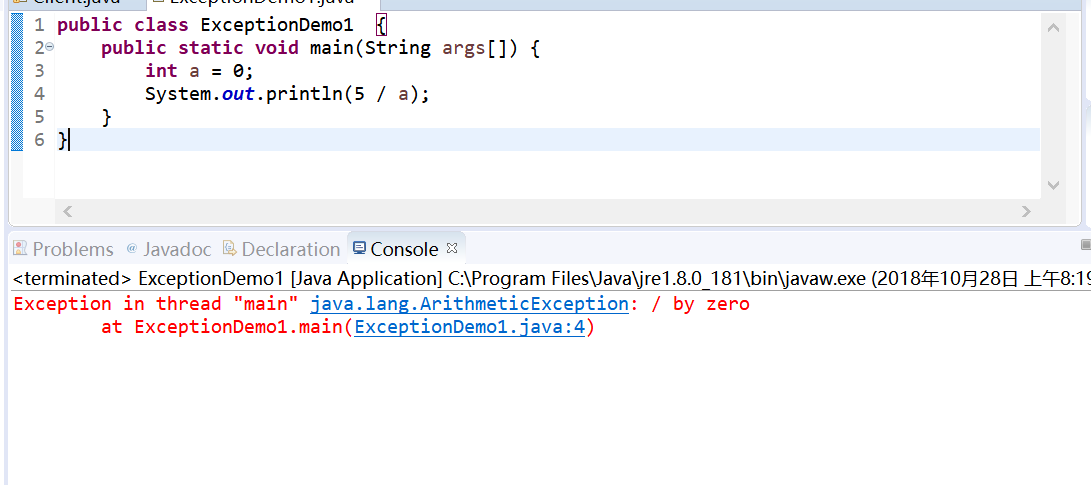
(2)

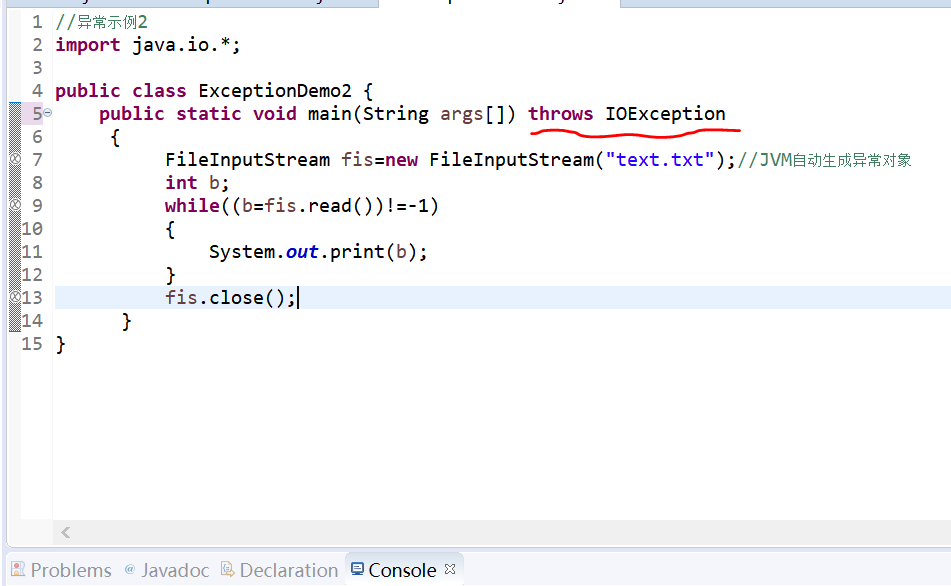
1 //异常示例2 2 import java.io.*; 3 4 public class ExceptionDemo2 { 5 public static void main(String args[]) throws Exception 6 { 7 FileInputStream fis=new FileInputStream("text.txt");//JVM自动生成异常对象 8 int b; 9 while((b=fis.read())!=-1) 10 { 11 System.out.print(b); 12 } 13 fis.close(); 14 } 15 }
实验2: 导入以下示例程序,测试程序并进行代码注释。
测试程序1:
l 在elipse IDE中编辑、编译、调试运行教材281页7-1,结合程序运行结果理解程序;
l 在程序中相关代码处添加新知识的注释;
l 掌握Throwable类的堆栈跟踪方法;
源代码:
package thesecond; import java.util.Scanner; /** * A program that displays a trace feature of a recursive method call. * @version 1.01 2004-05-10 * @author Cay Horstmann */ public class StackTraceTest { /** * Computes the factorial of a number * @param n a non-negative integer * @return n! = 1 * 2 * . . . * n */ public static int factorial(int n) { System.out.println("factorial(" + n + "):"); Throwable t = new Throwable();//在lang包中,不必写出; StackTraceElement[] frames = t.getStackTrace();//调用getStackTrace方法,得到StackTraceElement对象的一个数组; for (StackTraceElement f : frames) System.out.println(f); //递归算法; //每次return都是return栈顶那个计算得到的值,然后出栈,再把return得值作为已知条件来计算下个表达式 int r; if (n <= 1) r = 1; else r = n * factorial(n - 1);//n!=n*(n-1)!; System.out.println("return " + r); return r; } public static void main(String[] args) { Scanner in = new Scanner(System.in); System.out.print("Enter n: "); int n = in.nextInt(); factorial(n); } }
截图:
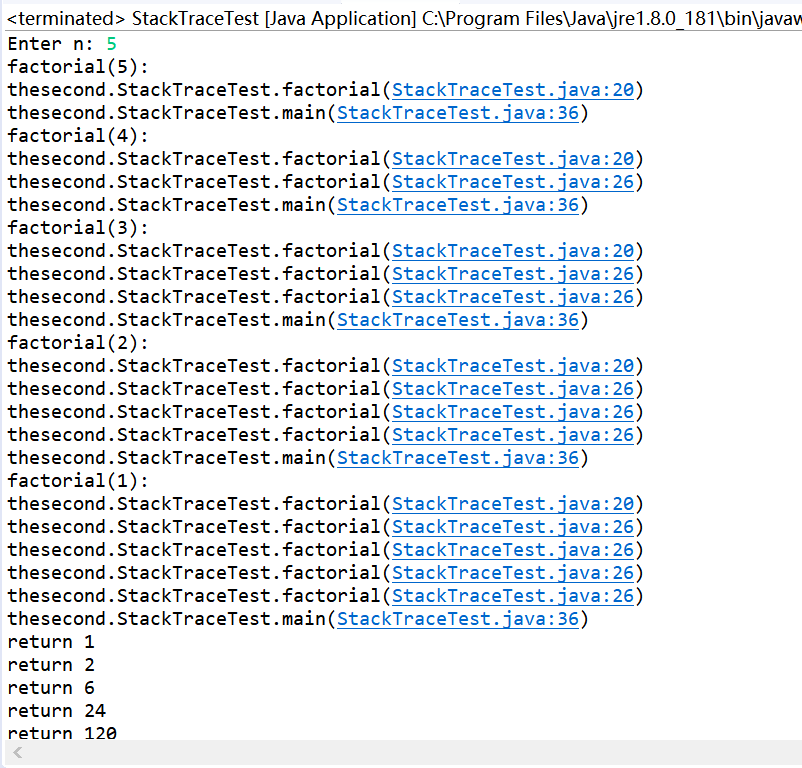
StackTrace就是当程序运行时一系列的函数调用的轨迹。
测试程序2
l Java语言的异常处理有积极处理方法和消极处理两种方式;
l 下列两个简答程序范例给出了两种异常处理的代码格式。在elipse IDE中编辑、调试运行源程序ExceptionalTest.java,将程序中的text文件更换为身份证号.txt,要求将文件内容读入内容,并在控制台显示;
l 掌握两种异常处理技术的特点。
|
//积极处理方式 import java.io.*; class ExceptionTest { public static void main (string args[]) { try{ FileInputStream fis=new FileInputStream("text.txt"); } catch(FileNotFoundExcption e) { …… } …… } } |
|
//消极处理方式 import java.io.*; class ExceptionTest { public static void main (string args[]) throws FileNotFoundExcption { FileInputStream fis=new FileInputStream("text.txt"); } } |
1 package thesecond; 2 //积极处理方式 3 import java.io.*; 4 import java.io.BufferedReader; 5 import java.io.FileReader; 6 7 class ExceptionTest { 8 public static void main (String args[]) 9 { 10 try{ 11 File fis=new File("身份证号.txt");// 创建File类对象fis,传递一个本地文件的绝对路径 12 13 FileReader f = new FileReader(fis); 14 BufferedReader b= new BufferedReader(f); 15 try { 16 String s, s2 = new String(); 17 while ((s = b.readLine()) != null) { 18 s2 += s + " "; 19 } 20 b.close(); 21 System.out.println(s2); 22 } 23 catch (IOException e) { 24 25 26 e.printStackTrace(); 27 } 28 } 29 catch (FileNotFoundException e) { 30 // TODO Auto-generated catch block 31 e.printStackTrace(); 32 } 33 34 } 35 }
package thesecond; import java.io.*; import java.io.BufferedReader; import java.io.FileReader; //消极处理方式 import java.io.*; class ExceptionTest { public static void main (String args[]) throws IOException { File fis=new File("身份证号.txt"); FileReader fr = new FileReader(fis); BufferedReader br = new BufferedReader(fr); String s, s2 = new String(); while ((s = br.readLine()) != null) { s2 += s + " "; } br.close(); System.out.println(s2); } }
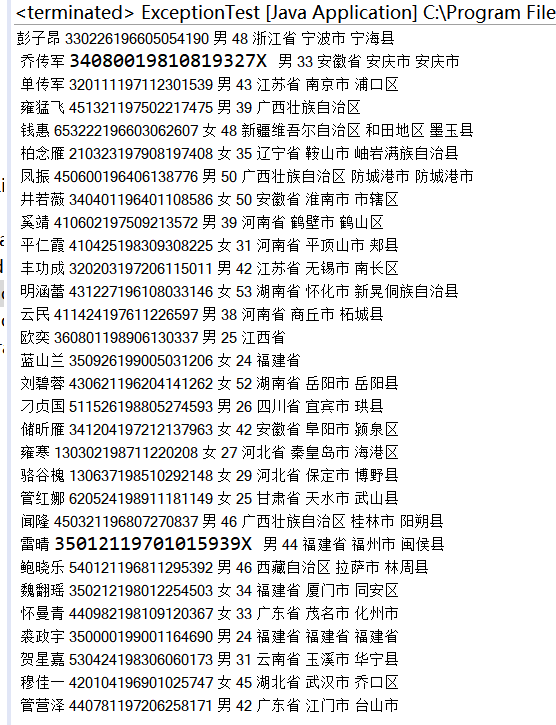
实验3: 编程练习
练习1:
l 编制一个程序,将身份证号.txt 中的信息读入到内存中;
l 按姓名字典序输出人员信息;
l 查询最大年龄的人员信息;
l 查询最小年龄人员信息;
l 输入你的年龄,查询身份证号.txt中年龄与你最近人的姓名、身份证号、年龄、性别和出生地;
l 查询人员中是否有你的同乡;
l 在以上程序适当位置加入异常捕获代码。
1 import java.io.BufferedReader; 2 import java.io.File; 3 import java.io.FileInputStream; 4 import java.io.FileNotFoundException; 5 import java.io.IOException; 6 import java.io.InputStreamReader; 7 import java.util.ArrayList; 8 import java.util.Arrays; 9 import java.util.Collections; 10 import java.util.Scanner; 11 12 13 public class Search{ 14 15 private static ArrayList<Person> Personlist1; 16 public static void main(String[] args) { 17 18 Personlist1 = new ArrayList<>(); 19 20 Scanner scanner = new Scanner(System.in); 21 File file = new File("E:\面向对象程序设计Java\实验\实验六\身份证号.txt"); 22 23 try { 24 FileInputStream F = new FileInputStream(file); 25 BufferedReader in = new BufferedReader(new InputStreamReader(F)); 26 String temp = null; 27 while ((temp = in.readLine()) != null) { 28 29 Scanner linescanner = new Scanner(temp); 30 31 linescanner.useDelimiter(" "); 32 String name = linescanner.next(); 33 String id = linescanner.next(); 34 String sex = linescanner.next(); 35 String age = linescanner.next(); 36 String place =linescanner.nextLine(); 37 Person Person = new Person(); 38 Person.setname(name); 39 Person.setid(id); 40 Person.setsex(sex); 41 int a = Integer.parseInt(age); 42 Person.setage(a); 43 Person.setbirthplace(place); 44 Personlist1.add(Person); 45 46 } 47 } catch (FileNotFoundException e) { 48 System.out.println("查找不到信息"); 49 e.printStackTrace(); 50 } catch (IOException e) { 51 System.out.println("信息读取有误"); 52 e.printStackTrace(); 53 } 54 boolean isTrue = true; 55 while (isTrue) { 56 System.out.println("******************************************"); 57 System.out.println("1:按姓名字典顺序输出信息;"); 58 System.out.println("2:查询最大年龄与最小年龄人员信息;"); 59 System.out.println("3:按省份找你的同乡;"); 60 System.out.println("4:输入你的年龄,查询年龄与你最近人的信息;"); 61 System.out.println("5:退出"); 62 System.out.println("******************************************"); 63 int type = scanner.nextInt(); 64 switch (type) { 65 case 1: 66 Collections.sort(Personlist1); 67 System.out.println(Personlist1.toString()); 68 break; 69 case 2: 70 71 int max=0,min=100;int j,k1 = 0,k2=0; 72 for(int i=1;i<Personlist1.size();i++) 73 { 74 j=Personlist1.get(i).getage(); 75 if(j>max) 76 { 77 max=j; 78 k1=i; 79 } 80 if(j<min) 81 { 82 min=j; 83 k2=i; 84 } 85 86 } 87 System.out.println("年龄最大:"+Personlist1.get(k1)); 88 System.out.println("年龄最小:"+Personlist1.get(k2)); 89 break; 90 case 3: 91 System.out.println("place?"); 92 String find = scanner.next(); 93 String place=find.substring(0,3); 94 String place2=find.substring(0,3); 95 for (int i = 0; i <Personlist1.size(); i++) 96 { 97 if(Personlist1.get(i).getbirthplace().substring(1,4).equals(place)) 98 { 99 System.out.println("你的同乡:"+Personlist1.get(i)); 100 } 101 } 102 103 break; 104 case 4: 105 System.out.println("年龄:"); 106 int yourage = scanner.nextInt(); 107 int close=ageclose(yourage); 108 int d_value=yourage-Personlist1.get(close).getage(); 109 System.out.println(""+Personlist1.get(close)); 110 111 break; 112 case 5: 113 isTrue = false; 114 System.out.println("再见!"); 115 break; 116 default: 117 System.out.println("输入有误"); 118 } 119 } 120 } 121 public static int ageclose(int age) { 122 int m=0; 123 int max=53; 124 int d_value=0; 125 int k=0; 126 for (int i = 0; i < Personlist1.size(); i++) 127 { 128 d_value=Personlist1.get(i).getage()-age; 129 if(d_value<0) d_value=-d_value; 130 if (d_value<max) 131 { 132 max=d_value; 133 k=i; 134 } 135 136 } return k; 137 138 } 139 140 141 142 } 143 144 145 146 147 148 149 150 151 //jiekouwenjiaan 152 153 154 public class Person implements Comparable<Person> { 155 private String name; 156 private String id; 157 private int age; 158 private String sex; 159 private String birthplace; 160 161 public String getname() { 162 return name; 163 } 164 public void setname(String name) { 165 this.name = name; 166 } 167 public String getid() { 168 return id; 169 } 170 public void setid(String id) { 171 this.id= id; 172 } 173 public int getage() { 174 175 return age; 176 } 177 public void setage(int age) { 178 // int a = Integer.parseInt(age); 179 this.age= age; 180 } 181 public String getsex() { 182 return sex; 183 } 184 public void setsex(String sex) { 185 this.sex= sex; 186 } 187 public String getbirthplace() { 188 return birthplace; 189 } 190 public void setbirthplace(String birthplace) { 191 this.birthplace= birthplace; 192 } 193 194 public int compareTo(Person o) { 195 return this.name.compareTo(o.getname()); 196 197 } 198 199 public String toString() { 200 return name+" "+sex+" "+age+" "+id+" "; 201 202 } 203 204 205 206 }


注:以下实验课后完成
练习2:
l 编写一个计算器类,可以完成加、减、乘、除的操作;
l 利用计算机类,设计一个小学生100以内数的四则运算练习程序,由计算机随机产生10道加减乘除练习题,学生输入答案,由程序检查答案是否正确,每道题正确计10分,错误不计分,10道题测试结束后给出测试总分;
l 将程序中测试练习题及学生答题结果输出到文件,文件名为test.txt;
1 import java.util.*; 2 import java.util.Scanner; 3 4 public class Calculator { 5 6 public static void main(String[] args) { 7 // 用户的答案要从键盘输入,因此需要一个键盘输入流 8 Scanner in = new Scanner(System.in); 9 // 定义一个变量用来统计得分 10 int sum = 0; 11 // 通过循环生成10道题 12 for (int i = 0; i < 10; i++) { 13 14 // 随机生成两个10以内的随机数作为被除数和除数 15 int a = (int) Math.round(Math.random() * 10); 16 int b = (int) Math.round(Math.random() * 10); 17 int c = (int) Math.round(Math.random() * 4); 18 19 int s; 20 21 switch(c) { 22 23 case 1: 24 s=a+b; 25 System.out.println(a + "+" + b + "="); 26 break; 27 case 2: 28 s=s=a-b; 29 System.out.println(a + "-" + b + "="); 30 break; 31 case 3: 32 s=a*b; 33 System.out.println(a + "*" + b + "="); 34 break; 35 case 4: 36 37 s=a/b; 38 System.out.println(a + "/" + b + "="); 39 40 break; 41 42 } 43 44 int s1 = in.nextInt(); 45 46 if (s1==s) { 47 sum += 10; 48 System.out.println("恭喜答案正确"); 49 } 50 else { 51 52 System.out.println("抱歉,答案错误"); 53 } 54 } 55 //输出用户的成绩 56 System.out.println("你的得分为"+sum); 57 } 58 59 }
l 在以上程序适当位置加入异常捕获代码。
实验4:断言、日志、程序调试技巧验证实验。
实验程序1:
|
//断言程序示例 public class AssertDemo { public static void main(String[] args) { test1(-5); test2(-3); }
private static void test1(int a){ assert a > 0; System.out.println(a); } private static void test2(int a){ assert a > 0 : "something goes wrong here, a cannot be less than 0"; System.out.println(a); } } |
l 在elipse下调试程序AssertDemo,结合程序运行结果理解程序;
//断言程序示例 public class AssertDemo { public static void main(String[] args) { test1(-5); test2(-3); } private static void test1(int a){ assert a > 0; System.out.println(a); } private static void test2(int a){ assert a > 0 : "something goes wrong here, a cannot be less than 0"; System.out.println(a); } }
l 注释语句test1(-5);后重新运行程序,结合程序运行结果理解程序;
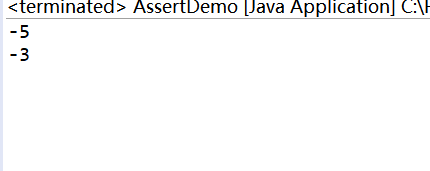
注释后运行:

l 掌握断言的使用特点及用法。
实验程序2:
l 用JDK命令调试运行教材298页-300页程序7-2,结合程序运行结果理解程序;
l 并掌握Java日志系统的用途及用法。
1 import java.awt.*; 2 import java.awt.event.*; 3 import java.io.*; 4 import java.util.logging.*; 5 import javax.swing.*; 6 7 /** 8 * A modification of the image viewer program that logs various events. 9 * @version 1.03 2015-08-20 10 * @author Cay Horstmann 11 */ 12 public class LoggingImageViewer 13 { 14 public static void main(String[] args) 15 { 16 if (System.getProperty("java.util.logging.config.class") == null 17 && System.getProperty("java.util.logging.config.file") == null) 18 { 19 try 20 { 21 Logger.getLogger("com.horstmann.corejava").setLevel(Level.ALL); 22 final int LOG_ROTATION_COUNT = 10; 23 Handler handler = new FileHandler("%h/LoggingImageViewer.log", 0, LOG_ROTATION_COUNT); 24 Logger.getLogger("com.horstmann.corejava").addHandler(handler); 25 } 26 catch (IOException e) 27 { 28 Logger.getLogger("com.horstmann.corejava").log(Level.SEVERE, 29 "Can't create log file handler", e); 30 } 31 } 32 33 EventQueue.invokeLater(() -> 34 { 35 Handler windowHandler = new WindowHandler(); 36 windowHandler.setLevel(Level.ALL); 37 Logger.getLogger("com.horstmann.corejava").addHandler(windowHandler); 38 39 JFrame frame = new ImageViewerFrame(); 40 frame.setTitle("LoggingImageViewer"); 41 frame.setDefaultCloseOperation(JFrame.EXIT_ON_CLOSE); 42 43 Logger.getLogger("com.horstmann.corejava").fine("Showing frame"); 44 frame.setVisible(true); 45 }); 46 } 47 } 48 49 /** 50 * The frame that shows the image. 51 */ 52 class ImageViewerFrame extends JFrame 53 { 54 private static final int DEFAULT_WIDTH = 300; 55 private static final int DEFAULT_HEIGHT = 400; 56 57 private JLabel label; 58 private static Logger logger = Logger.getLogger("com.horstmann.corejava"); 59 60 public ImageViewerFrame() 61 { 62 logger.entering("ImageViewerFrame", "<init>"); 63 setSize(DEFAULT_WIDTH, DEFAULT_HEIGHT); 64 65 // set up menu bar 66 JMenuBar menuBar = new JMenuBar(); 67 setJMenuBar(menuBar); 68 69 JMenu menu = new JMenu("File"); 70 menuBar.add(menu); 71 72 JMenuItem openItem = new JMenuItem("Open"); 73 menu.add(openItem); 74 openItem.addActionListener(new FileOpenListener()); 75 76 JMenuItem exitItem = new JMenuItem("Exit"); 77 menu.add(exitItem); 78 exitItem.addActionListener(new ActionListener() 79 { 80 public void actionPerformed(ActionEvent event) 81 { 82 logger.fine("Exiting."); 83 System.exit(0); 84 } 85 }); 86 87 // use a label to display the images 88 label = new JLabel(); 89 add(label); 90 logger.exiting("ImageViewerFrame", "<init>"); 91 } 92 93 private class FileOpenListener implements ActionListener 94 { 95 public void actionPerformed(ActionEvent event) 96 { 97 logger.entering("ImageViewerFrame.FileOpenListener", "actionPerformed", event); 98 99 // set up file chooser 100 JFileChooser chooser = new JFileChooser(); 101 chooser.setCurrentDirectory(new File(".")); 102 103 // accept all files ending with .gif 104 chooser.setFileFilter(new javax.swing.filechooser.FileFilter() 105 { 106 public boolean accept(File f) 107 { 108 return f.getName().toLowerCase().endsWith(".gif") || f.isDirectory(); 109 } 110 111 public String getDescription() 112 { 113 return "GIF Images"; 114 } 115 }); 116 117 // show file chooser dialog 118 int r = chooser.showOpenDialog(ImageViewerFrame.this); 119 120 // if image file accepted, set it as icon of the label 121 if (r == JFileChooser.APPROVE_OPTION) 122 { 123 String name = chooser.getSelectedFile().getPath(); 124 logger.log(Level.FINE, "Reading file {0}", name); 125 label.setIcon(new ImageIcon(name)); 126 } 127 else logger.fine("File open dialog canceled."); 128 logger.exiting("ImageViewerFrame.FileOpenListener", "actionPerformed"); 129 } 130 } 131 } 132 133 /** 134 * A handler for displaying log records in a window. 135 */ 136 class WindowHandler extends StreamHandler 137 { 138 private JFrame frame; 139 140 public WindowHandler() 141 { 142 frame = new JFrame(); 143 final JTextArea output = new JTextArea(); 144 output.setEditable(false); 145 frame.setSize(200, 200); 146 frame.add(new JScrollPane(output)); 147 frame.setFocusableWindowState(false); 148 frame.setVisible(true); 149 setOutputStream(new OutputStream() 150 { 151 public void write(int b) 152 { 153 } // not called 154 155 public void write(byte[] b, int off, int len) 156 { 157 output.append(new String(b, off, len)); 158 } 159 }); 160 } 161 162 public void publish(LogRecord record) 163 { 164 if (!frame.isVisible()) return; 165 super.publish(record); 166 flush(); 167 } 168 }

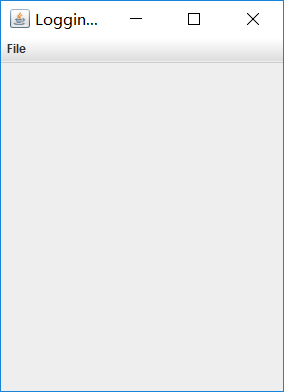
实验程序3:
l 用JDK命令调试运行教材298页-300页程序7-2,结合程序运行结果理解程序;
l 按课件66-77内容练习并掌握Elipse的常用调试技术。

package logging; import java.awt.*; import java.awt.event.*; import java.io.*; import java.util.logging.*; import javax.swing.*; /** * A modification of the image viewer program that logs various events. * @version 1.03 2015-08-20 * @author Cay Horstmann */ public class LoggingImageViewer { public static void main(String[] args) { if (System.getProperty("java.util.logging.config.class") == null && System.getProperty("java.util.logging.config.file") == null) { try { Logger.getLogger("com.horstmann.corejava").setLevel(Level.ALL); final int LOG_ROTATION_COUNT = 10; Handler handler = new FileHandler("%h/LoggingImageViewer.log", 0, LOG_ROTATION_COUNT); Logger.getLogger("com.horstmann.corejava").addHandler(handler); } catch (IOException e) { Logger.getLogger("com.horstmann.corejava").log(Level.SEVERE, "Can't create log file handler", e); } } EventQueue.invokeLater(() -> { Handler windowHandler = new WindowHandler(); windowHandler.setLevel(Level.ALL); Logger.getLogger("com.horstmann.corejava").addHandler(windowHandler); JFrame frame = new ImageViewerFrame(); frame.setTitle("LoggingImageViewer"); frame.setDefaultCloseOperation(JFrame.EXIT_ON_CLOSE); Logger.getLogger("com.horstmann.corejava").fine("Showing frame"); frame.setVisible(true); }); } } /** * The frame that shows the image. */ class ImageViewerFrame extends JFrame { private static final int DEFAULT_WIDTH = 300; private static final int DEFAULT_HEIGHT = 400; private JLabel label; private static Logger logger = Logger.getLogger("com.horstmann.corejava"); public ImageViewerFrame() { logger.entering("ImageViewerFrame", "<init>"); setSize(DEFAULT_WIDTH, DEFAULT_HEIGHT); // set up menu bar JMenuBar menuBar = new JMenuBar(); setJMenuBar(menuBar); JMenu menu = new JMenu("File"); menuBar.add(menu); JMenuItem openItem = new JMenuItem("Open"); menu.add(openItem); openItem.addActionListener(new FileOpenListener()); JMenuItem exitItem = new JMenuItem("Exit"); menu.add(exitItem); exitItem.addActionListener(new ActionListener() { public void actionPerformed(ActionEvent event) { logger.fine("Exiting."); System.exit(0); } }); // use a label to display the images label = new JLabel(); add(label); logger.exiting("ImageViewerFrame", "<init>"); } private class FileOpenListener implements ActionListener { public void actionPerformed(ActionEvent event) { logger.entering("ImageViewerFrame.FileOpenListener", "actionPerformed", event); // set up file chooser JFileChooser chooser = new JFileChooser(); chooser.setCurrentDirectory(new File(".")); // accept all files ending with .gif chooser.setFileFilter(new javax.swing.filechooser.FileFilter() { public boolean accept(File f) { return f.getName().toLowerCase().endsWith(".gif") || f.isDirectory(); } public String getDescription() { return "GIF Images"; } }); // show file chooser dialog int r = chooser.showOpenDialog(ImageViewerFrame.this); // if image file accepted, set it as icon of the label if (r == JFileChooser.APPROVE_OPTION) { String name = chooser.getSelectedFile().getPath(); logger.log(Level.FINE, "Reading file {0}", name); label.setIcon(new ImageIcon(name)); } else logger.fine("File open dialog canceled."); logger.exiting("ImageViewerFrame.FileOpenListener", "actionPerformed"); } } } /** * A handler for displaying log records in a window. */ class WindowHandler extends StreamHandler { private JFrame frame; public WindowHandler() { frame = new JFrame(); final JTextArea output = new JTextArea(); output.setEditable(false); frame.setSize(200, 200); frame.add(new JScrollPane(output)); frame.setFocusableWindowState(false); frame.setVisible(true); setOutputStream(new OutputStream() { public void write(int b) { } // not called public void write(byte[] b, int off, int len) { output.append(new String(b, off, len)); } }); } public void publish(LogRecord record) { if (!frame.isVisible()) return; super.publish(record); flush(); } }
第三部分:总结
这周学习java异常处理技术,了解断言的用法,了解日志的用途; 以及学习程序基础调试技巧。对程序编译以及运行时可能出现的异常问题有了初步认识,以及对出现的异常相对相应需要的处理技术。
